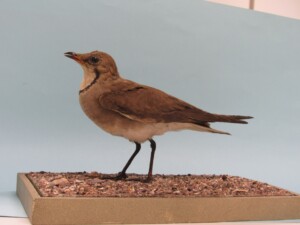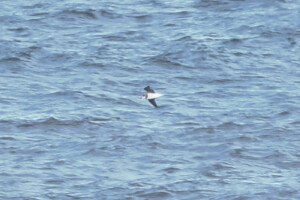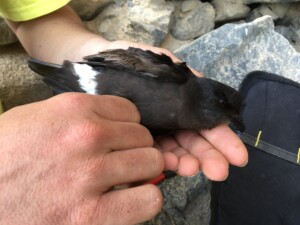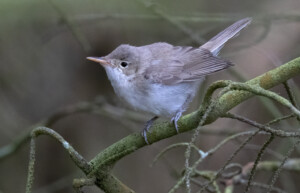Changes to the British List (13 Aug 2024)
The British Ornithologists’ Union Records Committee (BOURC) has made the following changes to the British List.
 Oriental Pratincole Glareola maldivarum
Oriental Pratincole Glareola maldivarum
New first record: one, second-calendar-year or older, female, 13 July 1908, Eilean Mòr, Flannan Isles, Outer Hebrides, specimen at National Museums Scotland, Edinburgh (Accession number NMS.Z 1908.130), pre-dates the previously accepted first record of this species and is therefore accepted as the first British record (Ibis 133: 218).
Photo (right): Oriental Pratincole (Eilean Mòr, Flannan Isles, Outer Hebrides, 13th July 1908) © Bob McGowan
This pratincole specimen collected at Eilean Mòr, Flannan Isles, Outer Hebrides and deposited at the Royal Scottish Museum was historically identified as a Collared Pratincole Glareola praticola (Annals of Scottish Natural History 17: 256). As part of a review of early historical records of Collared Pratincoles, a number of pratincole specimens located in public collections were examined, with this individual reidentified as an Oriental Pratincole G. maldivarum – primarily on account of its diagnostic short outermost tail feathers (Brit. Birds 117: 152-167, Dutch Birding 27: 1–35). This reidentification was later supported genetically by sequencing of one mitochondrial gene.
The record was judged against published BOURC criteria for historical records (Ibis 160: 936-942) and found to be acceptable as a new first British record of Oriental Pratincole.
Oriental Pratincole breeds in western India and Sri Lanka, southeast Asia to the Malay Peninsula, east and northeast China, Philippines, Taiwan, east Siberia, and Japan, and is migratory, wintering in India, Indonesia, northern Australia, and western Micronesia (IOC World Bird List (v 14.1)).
Previously Oriental Pratincole was added to the British List in 1990 on the basis of a 2CY at Dunwich, Suffolk on 22 June-8 July 1981 and what is presumed to have been the same individual present at Old Hall Marshes, Essex between about 6 August and about 11 October 1981 (Brit. Birds 82: 521, Brit. Birds 86: 115-120, Ibis 133: 218). Oriental Pratincole is now an established vagrant to Britain (seven records) and elsewhere in Europe in spring, summer, and autumn (Brit. Birds 104: 577, Dutch Birding 35: 65-68).
Oriental Pratincole is monotypic.
 Soft-plumaged Petrel Pterodroma mollis
Soft-plumaged Petrel Pterodroma mollis
Addition to Category A: one, at least first-calendar-year, Flamborough Head, Yorkshire, 1 July 2021 (photographed), then same later on 1 July 2021: Long Nab, Burniston, Yorkshire; Old Nab, Staithes, Yorkshire; Cowbar, Cleveland; Whitburn, County Durham (photographed); Brown’s Bay, Cullercoats, Northumberland; St Mary’s Island, Northumberland; Church Point, Newbiggin-by-the-Sea, Northumberland (photographed); Low Hauxley, Northumberland; Coquet Island, Northumberland; Cullernose Point, Craster, Northumberland; Beadnell Point, Northumberland; Annstead Point, Seahouses, Northumberland (videoed); Stag Rocks, Bamburgh, Northumberland.
Photo (right): Soft-plumaged Petrel (Newbiggin-by-the-Sea, Northumberland, 1st July 2021) © Graham Sorrie
This bird was first noted passing north at Flamborough Head, Yorkshire at 09:35 and was broadcast immediately as a Desertas Petrel/Fea’s Petrel Pterodroma deserta/feae to give other observers the opportunity to attempt to see it passing coastal locations further north along the North Sea coast. Accordingly, it was later recorded passing a further twelve locations until it was last seen at Stag Rocks, Bamburgh, Northumberland at 19:05; now 197 km north northwest of where it was initially seen. The bird was photographed or videoed at four of these locations and when this media was shared online an alternative identification of Soft-plumaged Petrel was proposed and agreed.
Soft-plumaged Petrel breeds on subtropical and subantarctic islands in the South Indian and South Atlantic oceans and ranges across pelagic waters of south Australasia, south Africa, south of Madagascar and southeast South America (IOC World Bird List (v 14.1)).
Soft-plumaged Petrel has previously been recorded as a vagrant to the Western Palearctic on two occasions: in the Gulf of Aqaba at both Aqaba, Jordan and Eilat, Israel on 25 March 1997, and at Nesseby, Finnmark, Norway on 6 June 2009 (Sandgrouse 21: 10, Sandgrouse 21: 49-50, Fugleåret 1: 4-87). Other vagrant ‘tube-nosed seabirds’ in the order Procellariiformes from the Southern Oceans already accepted as vagrants to Britain include Atlantic Yellow-nosed Albatross Thalassarche chlororhynchos, Black-browed Albatross Thalassarche melanophris and White-chinned Petrel Procellaria aequinoctialis, with records of White-bellied Storm Petrel/Black-bellied Storm Petrel Fregetta grallaria/tropica and Southern Giant Petrel/Northern Giant Petrel Macronectes giganteus/halli not identified to species level. This species is unknown in captivity.
Soft-plumaged Petrel is monotypic and should be placed after Fulmar Fulmarus glacialis on the British List.
 Madeiran Petrel Hydrobates castro
Madeiran Petrel Hydrobates castro
Band-rumped Storm Petrel
Addition to Category A: one, at least third-calendar-year, At Sea, Sea area FitzRoy, ca. 48° 28′ N, 9° 52′ W, 16-17 November 2021 (GPS-tagged ‘LX07518’).
Photo (right): Madeiran Petrel (Anaga Islet, Tenerife, Canary Islands, Spain, November 2021) © Clara Morey
Madeiran Petrels breeding on Anaga Islet, Tenerife (Canary Islands, Spain) were fitted with GPS-tags (accurate to within several metres) in November 2021 to help elucidate their at-sea distribution. One individual ‘LX07518’ undertook a nine-day foraging trip covering 6,151 km up to 2,580 km from its breeding colony where, after visiting contiguous Irish waters (and becoming a potential national first there), it was logged in British waters ca. 285 km southwest of Bishop Rock, Isles of Scilly; first at 21:14 on 16 November 2021 and last at 08:14 on 17 November 2021 (Brit. Birds 116: 232–234). After departing British waters it soon entered French waters where it has recently been accepted as a national first (previous records there were only accepted as ‘Madeiran Petrel/Monteiro’s Petrel/Cape Verde Petrel Hydrobates castro/monteiroi/jabejabe’).
This record represents the first species to be added to the British List without the individual bird being seen here either alive or dead inside British territory and its occurrence prompted clarification by the Committee of how we judge records of birds without a human observer (Ibis 166: 350-351).
Madeiran Petrel occurs widely in the Atlantic and Pacific Oceans (IOC World Bird List (v 14.1)). This species is unknown in captivity.
Madeiran Petrel has previously been on the British List twice before. A historic record latterly placed in Category B of one found dead at Milford-on-Sea, Hampshire, in November 1911, was removed from the British List in 2008 as there was no published description or traceable specimen (Ibis 151: 225). Subsequently one recorded At Sea off the Isles of Scilly in Sea area Sole on 28 July 2007, was admitted to the British List but was then removed following taxonomic changes and it was considered to be acceptable at only the level of the species group ‘Madeiran Petrel/Monteiro’s Petrel/Cape Verde Petrel Hydrobates castro/monteiroi/jabejabe’ (Ibis 154: 212–213, Ibis 155: 204). There are now a total of five accepted records of unidentified ‘Madeiran /Monteiro’s/Cape Verde Petrel’ in Britain with the most recent record in 2022 (Brit. Birds 116: 546-602).
Madeiran Petrel should be placed after Leach’s Petrel Hydrobates leucorhoa on the British List and is currently treated as monotypic. However, the IOC World Bird List (v 14.1) suggests that in the future Madeiran Petrel may be treated as comprising ‘five or more species worldwide including cryptic sympatric species that breed at different seasons. Grant’s Storm Petrel (Hydrobates sp. nov.), a cool water form, is one of these’ and the Madeiran Petrel ‘LX07518’ tracked to Britain on 16-17 November 2021 was tagged in a colony of this cool water winter-breeding population (Brit. Birds 116: 232–234).
 Grey-headed Lapwing Vanellus cinereus
Grey-headed Lapwing Vanellus cinereus
Addition to Category A: one, at least third-calendar-year, Low Newton-by-the-Sea and Long Nanny, Northumberland, 1-8 May 2023 (photographed); same Airdrie Farm, Crail, Fife, 11 May 2023 (videoed); same Balormie, Lossiemouth, Moray & Nairn, 13 May 2023 (photographed); same Balemore, North Uist, Outer Hebrides, 26-29 May 2023 (photographed).
Photo (right): Grey-headed Lapwing (Low Newton-by-the-Sea, Northumberland, 1st May 2023) © Paul Ellis
The Grey-headed Lapwing was recorded in Britain over a period of 29 days during which time it relocated a straight-line distance of 425 km to the northwest.
Grey-headed Lapwing breeds in north central, and north east China, and central and southern Japan and is highly migratory, wintering in northeast and south India through southeast Asia to the Malay Peninsula, north and south Vietnam and southeast China (IOC World Bird List (v 14.1)).
There are six previous records of Grey-headed Lapwing in the Western Palearctic sensu stricto from Turkey, Norway, Sweden, the Netherlands, Slovenia, and Italy; all since March 2018. The records from Norway and Sweden are considered to be the same individual, but it is unclear how many other individuals have been involved in these sightings (Dutch Birding 43: 19-22, Fågelåret 2019: 101, 196, Avocetta 46: 126-127). The species has also been recorded as a vagrant to Australia, Indonesia, Iran, Kazakhstan, Nicobar Islands, Oman, Pakistan, Philippines, Russia, Singapore, and Sri Lanka.
Five other species of lapwing Vanellus have occurred in Britain as escapes from captivity and although Grey-headed Lapwing is known to have been held in zoological collections in Europe previously it is not known in captivity here currently.
Based on its geographic range and migration Chinese Pond Heron Ardeola bacchus is a comparable previous non-passerine vagrant to Britain whilst other species of migratory shorebird Charadriiformes emanating from the Eastern Palearctic that have occurred here as vagrants include Siberian Sand Plover Anarhynchus mongolus and Oriental Pratincole Glareola maldivarum.
Grey-headed Lapwing is monotypic and should be placed after Lapwing (Northern Lapwing) Vanellus vanellus on the British List.
 Black-winged Kite Elanus caeruleus caeruleus
Black-winged Kite Elanus caeruleus caeruleus
Addition to Category A: one, at least first-calendar-year, Glan-Mule, Montgomeryshire 18 April 2023 (videoed); presumed same Brayden Marshes, Horsey, and Trimingham, Norfolk 17-20 July 2023 (photographed); presumed same Felixstowe Ferry and King’s Fleet, Suffolk, 20-21 July 2023 (photographed); presumed same St Osyth Marsh, Essex, 21-22 July 2023 (photographed).
Photo (right): Black-winged Kite (Felixstowe Ferry, Suffolk, 21st July 2023) © Paul Ellis
The videos and description taken in Montgomeryshire on 18 April were not sufficiently detailed to enable confirmation that it was same individual as that present in Norfolk and Suffolk in July, but the consensus of the Committee was that all records could be presumed to relate to the same bird.
Although plumage traits suggested that this bird was likely to be in its second-calendar-year, there was not a consensus on the age of the bird, with precise ageing further complicated by the species breeding year-round.
Black-winged Kite occurs in the Palearctic, Afrotropical, Indomalayan and Australasian realms and although non migratory it is dispersive with increased vagrancy associated with range-expansion (Dutch Birding 39: 1-12). In the last century the nominate subspecies of Black-winged Kite colonised Europe from Africa breeding first in Portugal from 1944, Spain from 1973 and France from 1990 and had been recorded in 15 European countries by the end of 2016 (Animals 12: 2070, Dutch Birding 39: 1-12). The increase in Black-winged Kite occurrences in the Netherlands led to it being ceased to be considered a national rarity after 2021, by which time 74 individuals had been recorded there, including 18 in that last year alone (Dutch Birding 44: 410-413).
Black-winged Kite is held in captivity in Britain, but there was no reason to believe this individual was not a genuine vagrant, and its acceptance as wild was unanimous.
Black-winged Kite should be placed after Osprey Pandion haliaetus on the British List.
Black-winged Kite is polytypic, and this individual was of the nominate western subspecies caeruleus based on diagnostic plumage traits.
 Western Olivaceous Warbler Iduna opaca
Western Olivaceous Warbler Iduna opaca
Addition to Category A: one, first-calendar-year, Skibberhoull, Whalsay, Shetland, 20-21 October 2023 (trapped, photographed).
Photo (right): Western Olivaceous Warbler (Skibberhoull, Whalsay, Shetland, 21st October 2023) © Roger Riddington
Initially identified in the field on 20 October 2023 as the congeneric Eastern Olivaceous Warbler I. pallida, before photographs were circulated online and an alternative identification of Western Olivaceous Warbler Iduna opaca was suggested. On 21 October field observations supported this suspicion, and on being trapped for the purposes of ringing biometrics confirmed the identification as Western Olivaceous Warbler, which was later further supported genetically by sequencing of one mitochondrial gene.
Western Olivaceous Warbler breeds in southwest Europe and northwest Africa, and is migratory, wintering in West Africa (IOC World Bird List (v 14.1)).
Western Olivaceous Warbler has previously been recorded as an autumn vagrant in northern Europe to Sweden and Germany and is not known in captivity (Fågelåret 2004: 148-149, Ornithol. Jber. Helgoland 33: 105-112).
Western Olivaceous Warbler has a range and migration pattern within the Western Palearctic similar to other taxa already on the British List such as Red-necked Nightjar Caprimulgus ruficollis ruficollis, White-rumped Swift Apus caffer, and Rufous-tailed Scrub Robin Cercotrichas galactotes galactotes.
Earlier published records of Western Olivaceous Warbler in Britain – in Pembrokeshire on 23 September to 3 October 1951, and on the Isles of Scilly 3-4 October 1961 and 30 September to 2 October 1962 – were reviewed by the Committee in 2005 and found to be insufficiently substantiated (Ibis 142: 177, 147: 248).
Western Olivaceous Warbler is monotypic and should be placed after Eastern Olivaceous Warbler on the British List.
These changes will be published as part of the BOURC’s 57th report due to be published in Ibis in January 2025. Upon publication of this change, the British List stands at 641 species (Category A = 623; Category B = 8; Category C = 10).


